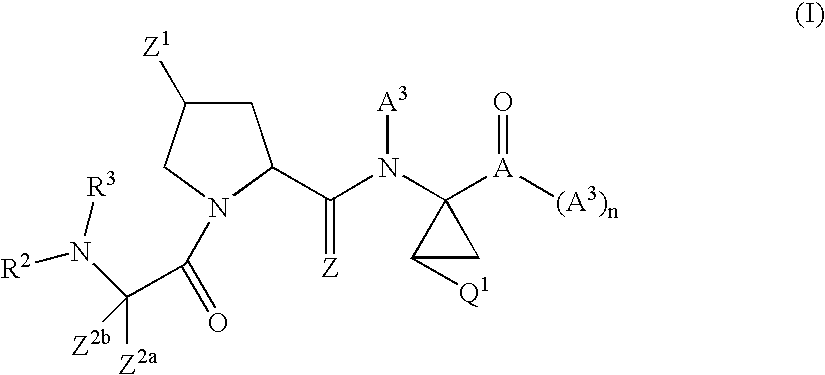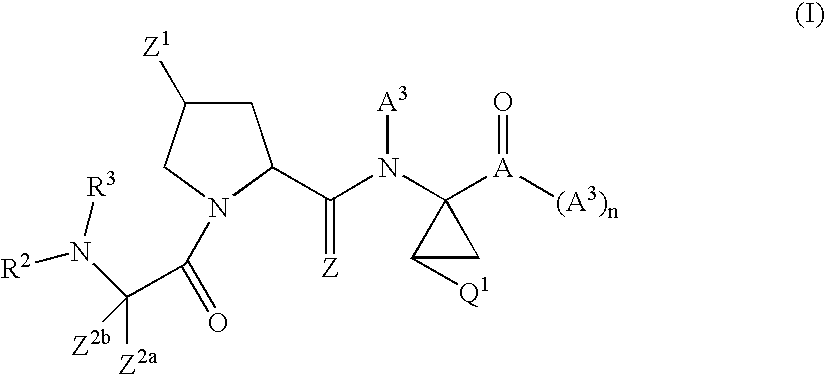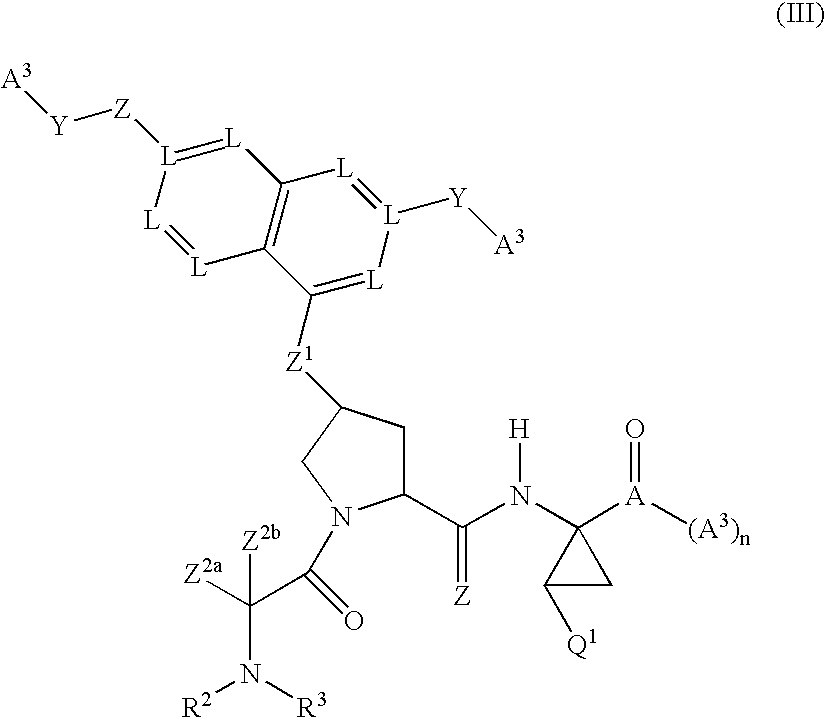Antiviral compounds
- Summary
- Abstract
- Description
- Claims
- Application Information
AI Technical Summary
Benefits of technology
Problems solved by technology
Method used
Image
Examples
example 1
Preparation of Compound 1
[0716]
[0717] Step 1. A solution of (1-Benzyloxycarbonylamino-2-vinyl-cyclopropyl)-methyl-phosphinic acid ethyl ester (100 mg, 0.308 mmol) in ACN (7.7 mL) was cooled to 0° C. and TMSI (220 μL, 1.54 mmol) was added in a drop-wise fashion. The reaction was warmed to rt and stirred for an hour. The reaction was then cooled to 0° C. and additional TMSI (110 L, 0.77 mmol) was added in a drop-wise fashion. The reaction was warmed to rt and stirred for 30 min. The reaction was cooled back to 0° C. and 2,6-lutidine (360 L, 3.1 mmol) was added in a drop-wise fashion. This was followed by the addition of Et3N (1 mL, 7.2 mmol) and MeOH (4 mL). The reaction was then concentrated in vacuum and crude intermediate was used directly in the next reaction. Step 2. A solution of dipeptide (81 mg, 0.123 mmol) in THF (2 mL) was cooled to −30° C. Et3N (34 L, 0.246 mmol) was added to this solution followed by ClCO2Et (18 L, 0.185 mmol). The reaction was stirred at a temperature bet...
example 2
Preparation of Compound 2
[0721]
[0722] Step 1. A solution of (1-Benzyloxycarbonylamino-2-vinyl-cyclopropyl)-sec-butyl-phosphinic acid ethyl ester (112 mg, 0.308 mmol) in ACN (7.7 mL) was cooled to 0° C. and TMSI (220 L, 1.54 mmol) was added in a drop-wise fashion. The reaction was warmed to rt and stirred for an hour. The reaction was then cooled to 0° C. and additional TMSI (110 L, 0.77 mmol) was added in a drop-wise fashion. The reaction was warmed to rt and stirred for 30 min. The reaction was cooled back to 0° C. and 2,6-lutidine (360 L, 3.1 mmol) was added in a drop-wise fashion. This was followed by the addition of Et3N (1 mL, 7.2 mmol) and MeOH (4 mL). The reaction was then concentrated in vacuum and crude was used directly in the next reaction.
[0723] Step 2. A solution of dipeptide (81 mg, 0.123 mmol) in THF (2 mL) was cooled to −30° C. Et3N (34 L, 0.246 mmol) was added to this solution followed by ClCO2Et (18 L, 0.185 mmol). The reaction was stirred at a temperature between...
example 3
Preparation of Compound 3
[0727]
[0728] Step 1. A solution of (1-Benzyloxycarbonylamino-2-vinyl-cyclopropyl)-isopropyl-phosphinic acid ethyl ester (108 mg, 0.308 mmol) in ACN (7.7 mL) was cooled to 0° C. and TMSI (220 L, 1.54 mmol) was added in a drop-wise fashion. The reaction was warmed to rt and stirred for an hour. The reaction was then cooled to 0° C. and additional TMSI (110 L, 0.77 mmol) was added in a drop-wise fashion. The reaction was warmed to rt and stirred for 30 min. The reaction was cooled back to 0° C. and 2,6-lutidine (360 L, 3.1 mmol) was added in a drop-wise fashion. This was followed by the addition of Et3N (1 mL, 7.2 mmol) and MeOH (4 mL). The reaction was then concentrated in vacuum and crude was used directly in the next reaction.
[0729] Step 2. A solution of 6 (81 mg, 0.123 mmol) in THF (2 mL) was cooled to −30° C. Et3N (34 L, 0.246 mmol) was added to this solution followed by ClCO2Et (18L, 0.185 mmol). The reaction was stirred at a temperature between −20° C. ...
PUM
| Property | Measurement | Unit |
|---|---|---|
| Composition | aaaaa | aaaaa |
Abstract
Description
Claims
Application Information
 Login to View More
Login to View More - R&D
- Intellectual Property
- Life Sciences
- Materials
- Tech Scout
- Unparalleled Data Quality
- Higher Quality Content
- 60% Fewer Hallucinations
Browse by: Latest US Patents, China's latest patents, Technical Efficacy Thesaurus, Application Domain, Technology Topic, Popular Technical Reports.
© 2025 PatSnap. All rights reserved.Legal|Privacy policy|Modern Slavery Act Transparency Statement|Sitemap|About US| Contact US: help@patsnap.com



